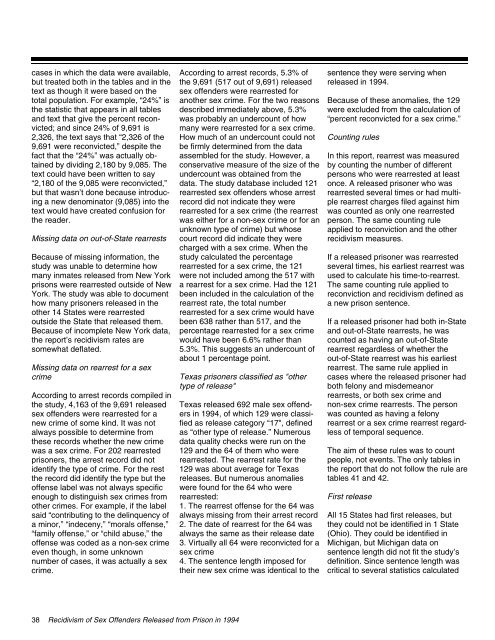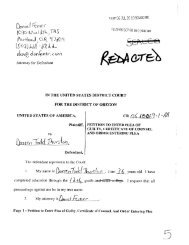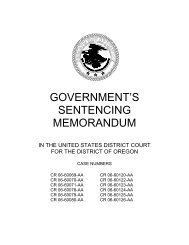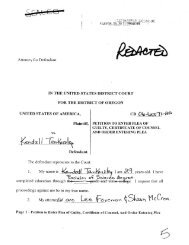Methodology3-year followup periodFor analytic purposes, "3 years" wasdef<strong>in</strong>ed as 1,096 days <strong>from</strong> the day <strong>of</strong>release <strong>from</strong> prison. Any rearrest,reconviction, or re-imprisonment occurr<strong>in</strong>gafter 1,096 days <strong>from</strong> the <strong>1994</strong>release was not <strong>in</strong>cluded. A convictionafter 1,096 days was not counted evenif it resulted <strong>from</strong> an arrest with<strong>in</strong> theperiod.Separat<strong>in</strong>g sex <strong>of</strong>fenders <strong>in</strong>to fourtypesThe report gives statistics for four types<strong>of</strong> sex <strong>of</strong>fenders. Separat<strong>in</strong>g sex <strong>of</strong>fenders<strong>in</strong>to the four types was done us<strong>in</strong>g<strong>in</strong>formation — <strong>in</strong> particular, the statutenumber for the imprisonment <strong>of</strong>fense,the literal version <strong>of</strong> the statute, anumeric FBI code (called the “NCIC”code, short for “National Crime InformationCenter”) <strong>in</strong>dicat<strong>in</strong>g what theimprisonment <strong>of</strong>fense was, and miscellaneousother <strong>in</strong>formation — available<strong>in</strong> the prison records on the 9,691 men.However, the prison records obta<strong>in</strong>edfor the study did not always conta<strong>in</strong> allfour pieces <strong>of</strong> <strong>in</strong>formation on theimprisonment <strong>of</strong>fense. Moreover, theavailable <strong>of</strong>fense <strong>in</strong>formation was notalways detailed enough to reliablydist<strong>in</strong>guish different types <strong>of</strong> sex<strong>of</strong>fenders.The process <strong>of</strong> sort<strong>in</strong>g sex <strong>of</strong>fenders<strong>in</strong>to different types <strong>in</strong>volved first creat<strong>in</strong>gthe study’s def<strong>in</strong>itions <strong>of</strong> the fourtypes, and then determ<strong>in</strong><strong>in</strong>g whichState statute numbers, which literalversions <strong>of</strong> those statutes, and whichNCIC codes conformed to the def<strong>in</strong>itions.Each <strong>in</strong>mate was next classified<strong>in</strong>to one <strong>of</strong> the types (or possibly <strong>in</strong>tomore than one type, s<strong>in</strong>ce the four arenot mutually exclusive) depend<strong>in</strong>g onwhether the imprisonment <strong>of</strong>fense<strong>in</strong>formation available on him fit thestudy’s def<strong>in</strong>ition.An obstacle to classify<strong>in</strong>g sex <strong>of</strong>fenders<strong>in</strong>to types was that the labels “rape,”“sexual assault,” “child molestation,”“statutory rape” were not widely used <strong>in</strong>State statutes, and when they wereused they did not always conform tothe study’s def<strong>in</strong>itions <strong>of</strong> them. Indecid<strong>in</strong>g which type <strong>of</strong> sex <strong>of</strong>fender toclassify the prisoner as, importancewas attached not to the label the lawgave to his conviction <strong>of</strong>fense, but tohow well the law’s def<strong>in</strong>ition <strong>of</strong> the<strong>of</strong>fense fit the study’s def<strong>in</strong>ition <strong>of</strong> thetype.<strong>Sex</strong> <strong>of</strong>fenders compared to non-sex<strong>of</strong>fendersIn <strong>1994</strong>, prisons <strong>in</strong> 15 States released272,111 prisoners, represent<strong>in</strong>gtwo-thirds <strong>of</strong> all prisoners released <strong>in</strong>the United States that year. Among the272,111 were 262,420 released prisonerswhose imprisonment <strong>of</strong>fense wasnot a sex <strong>of</strong>fense. Non-sex <strong>of</strong>fenders<strong>in</strong>clude <strong>in</strong>mates, both male and female,who were <strong>in</strong> prison for violent crimes(such as murder or robbery), propertycrimes (such as burglary or motorvehicle theft), drug crimes, and publicorder <strong>of</strong>fenses. Like the 9,691 malesex <strong>of</strong>fenders exam<strong>in</strong>ed <strong>in</strong> this report,all non-sex <strong>of</strong>fenders were serv<strong>in</strong>gprison terms <strong>of</strong> one year or more <strong>in</strong>State prison when they were released<strong>in</strong> <strong>1994</strong>.At various places, this report compares9,691 released male sex <strong>of</strong>fenders to262,420 released non-sex <strong>of</strong>fenders.While labeled “non-sex <strong>of</strong>fenders,” the262,420 actually <strong>in</strong>cludes a smallnumber- 87- who are sex <strong>of</strong>fenders.The 87 are all the female sex <strong>of</strong>fendersreleased <strong>from</strong> prisons <strong>in</strong> the 15 States<strong>in</strong> <strong>1994</strong>.Ages <strong>of</strong> molested and allegedlymolested childrenInformation on the ages <strong>of</strong> molestedchildren was needed for two calculations:1) age <strong>of</strong> the child the releasedsex <strong>of</strong>fender was sent to prison formolest<strong>in</strong>g, and 2) age <strong>of</strong> the child allegedlymolested by the released sex<strong>of</strong>fender dur<strong>in</strong>g the 3-year follow-upperiod. The most frequent source <strong>of</strong>both was a sex statute: either the sexstatute the <strong>of</strong>fender was imprisoned forviolat<strong>in</strong>g, or the statute the releasedprisoner was charged with violat<strong>in</strong>gwhen he was rearrested for a sexcrime. The former was obta<strong>in</strong>ed <strong>from</strong>the prison records assembled for thestudy; the latter, <strong>from</strong> the assembledarrest records.None <strong>of</strong> the sex statutes was found toapply to a victim <strong>of</strong> a specific age; forexample, just to 12-year-olds. Butsome were found to apply just tochildren <strong>in</strong> a certa<strong>in</strong> age range; forexample, under 12, or 13 to 15, or 16to 17. While specific ages <strong>of</strong> childrencould not be obta<strong>in</strong>ed <strong>from</strong> statutes,the availability <strong>of</strong> <strong>in</strong>formation on ageranges at least made it possible toobta<strong>in</strong> approximate ages. The rule thatwas adopted was to record the victim’s(or alleged victim’s) age as the upperlimit <strong>of</strong> a statute’s age range. To illustrate,a statute might <strong>in</strong>dicate that thecompla<strong>in</strong>ant/victim be “at least 13 butless than 16 years <strong>of</strong> age.” In that case,the age <strong>of</strong> the child was recorded as15, s<strong>in</strong>ce the statute <strong>in</strong>dicated theupper limit <strong>of</strong> the age range as any age“less than 16.” As another example, if astatute <strong>in</strong>dicated the compla<strong>in</strong>ant/victim be “under 12 years <strong>of</strong> age,” thechild’s age was recorded as 11, as thephras<strong>in</strong>g <strong>of</strong> the age range did not<strong>in</strong>clude 12-year-olds, only those “under12.” Because the victim (or allegedvictim) was always assigned the age <strong>of</strong>the oldest person <strong>in</strong> the age range, thestudy made the victims (or allegedvictims) appear older than they actuallywere.How miss<strong>in</strong>g data were handled <strong>in</strong> thereportIn many <strong>in</strong>stances, the data needed tocalculate a statistic were not availablefor all 9,691 released sex <strong>of</strong>fenders.For example, the 9,691 were released<strong>in</strong> 15 States, but data needed to determ<strong>in</strong>ethe number reconvicted were onlyavailable for the 9,085 released <strong>in</strong> 14 <strong>of</strong>the 15. Of the 9,085, 2,180 (24%) werereconvicted. When data were miss<strong>in</strong>g,the statistic was computed on those<strong>Recidivism</strong> <strong>of</strong> <strong>Sex</strong> Offenders <strong>Released</strong> <strong>from</strong> <strong>Prison</strong> <strong>in</strong> <strong>1994</strong> 37
cases <strong>in</strong> which the data were available,but treated both <strong>in</strong> the tables and <strong>in</strong> thetext as though it were based on thetotal population. For example, “24%” isthe statistic that appears <strong>in</strong> all tablesand text that give the percent reconvicted;and s<strong>in</strong>ce 24% <strong>of</strong> 9,691 is2,326, the text says that “2,326 <strong>of</strong> the9,691 were reconvicted,” despite thefact that the “24%” was actually obta<strong>in</strong>edby divid<strong>in</strong>g 2,180 by 9,085. Thetext could have been written to say“2,180 <strong>of</strong> the 9,085 were reconvicted,”but that wasn’t done because <strong>in</strong>troduc<strong>in</strong>ga new denom<strong>in</strong>ator (9,085) <strong>in</strong>to thetext would have created confusion forthe reader.Miss<strong>in</strong>g data on out-<strong>of</strong>-State rearrestsBecause <strong>of</strong> miss<strong>in</strong>g <strong>in</strong>formation, thestudy was unable to determ<strong>in</strong>e howmany <strong>in</strong>mates released <strong>from</strong> New Yorkprisons were rearrested outside <strong>of</strong> NewYork. The study was able to documenthow many prisoners released <strong>in</strong> theother 14 States were rearrestedoutside the State that released them.Because <strong>of</strong> <strong>in</strong>complete New York data,the report’s recidivism rates aresomewhat deflated.Miss<strong>in</strong>g data on rearrest for a sexcrimeAccord<strong>in</strong>g to arrest records compiled <strong>in</strong>the study, 4,163 <strong>of</strong> the 9,691 releasedsex <strong>of</strong>fenders were rearrested for anew crime <strong>of</strong> some k<strong>in</strong>d. It was notalways possible to determ<strong>in</strong>e <strong>from</strong>these records whether the new crimewas a sex crime. For 202 rearrestedprisoners, the arrest record did notidentify the type <strong>of</strong> crime. For the restthe record did identify the type but the<strong>of</strong>fense label was not always specificenough to dist<strong>in</strong>guish sex crimes <strong>from</strong>other crimes. For example, if the labelsaid “contribut<strong>in</strong>g to the del<strong>in</strong>quency <strong>of</strong>a m<strong>in</strong>or,” “<strong>in</strong>deceny,” “morals <strong>of</strong>fense,”“family <strong>of</strong>fense,” or “child abuse,” the<strong>of</strong>fense was coded as a non-sex crimeeven though, <strong>in</strong> some unknownnumber <strong>of</strong> cases, it was actually a sexcrime.Accord<strong>in</strong>g to arrest records, 5.3% <strong>of</strong>the 9,691 (517 out <strong>of</strong> 9,691) releasedsex <strong>of</strong>fenders were rearrested foranother sex crime. For the two reasonsdescribed immediately above, 5.3%was probably an undercount <strong>of</strong> howmany were rearrested for a sex crime.How much <strong>of</strong> an undercount could notbe firmly determ<strong>in</strong>ed <strong>from</strong> the dataassembled for the study. However, aconservative measure <strong>of</strong> the size <strong>of</strong> theundercount was obta<strong>in</strong>ed <strong>from</strong> thedata. The study database <strong>in</strong>cluded 121rearrested sex <strong>of</strong>fenders whose arrestrecord did not <strong>in</strong>dicate they wererearrested for a sex crime (the rearrestwas either for a non-sex crime or for anunknown type <strong>of</strong> crime) but whosecourt record did <strong>in</strong>dicate they werecharged with a sex crime. When thestudy calculated the percentagerearrested for a sex crime, the 121were not <strong>in</strong>cluded among the 517 witha rearrest for a sex crime. Had the 121been <strong>in</strong>cluded <strong>in</strong> the calculation <strong>of</strong> therearrest rate, the total numberrearrested for a sex crime would havebeen 638 rather than 517, and thepercentage rearrested for a sex crimewould have been 6.6% rather than5.3%. This suggests an undercount <strong>of</strong>about 1 percentage po<strong>in</strong>t.Texas prisoners classified as "othertype <strong>of</strong> release"Texas released 692 male sex <strong>of</strong>fenders<strong>in</strong> <strong>1994</strong>, <strong>of</strong> which 129 were classifiedas release category “17", def<strong>in</strong>edas “other type <strong>of</strong> release.” Numerousdata quality checks were run on the129 and the 64 <strong>of</strong> them who wererearrested. The rearrest rate for the129 was about average for Texasreleases. But numerous anomalieswere found for the 64 who wererearrested:1. The rearrest <strong>of</strong>fense for the 64 wasalways miss<strong>in</strong>g <strong>from</strong> their arrest record2. The date <strong>of</strong> rearrest for the 64 wasalways the same as their release date3. Virtually all 64 were reconvicted for asex crime4. The sentence length imposed fortheir new sex crime was identical to thesentence they were serv<strong>in</strong>g whenreleased <strong>in</strong> <strong>1994</strong>.Because <strong>of</strong> these anomalies, the 129were excluded <strong>from</strong> the calculation <strong>of</strong>“percent reconvicted for a sex crime.”Count<strong>in</strong>g rulesIn this report, rearrest was measuredby count<strong>in</strong>g the number <strong>of</strong> differentpersons who were rearrested at leastonce. A released prisoner who wasrearrested several times or had multiplerearrest charges filed aga<strong>in</strong>st himwas counted as only one rearrestedperson. The same count<strong>in</strong>g ruleapplied to reconviction and the otherrecidivism measures.If a released prisoner was rearrestedseveral times, his earliest rearrest wasused to calculate his time-to-rearrest.The same count<strong>in</strong>g rule applied toreconviction and recidivism def<strong>in</strong>ed asa new prison sentence.If a released prisoner had both <strong>in</strong>-Stateand out-<strong>of</strong>-State rearrests, he wascounted as hav<strong>in</strong>g an out-<strong>of</strong>-Staterearrest regardless <strong>of</strong> whether theout-<strong>of</strong>-State rearrest was his earliestrearrest. The same rule applied <strong>in</strong>cases where the released prisoner hadboth felony and misdemeanorrearrests, or both sex crime andnon-sex crime rearrests. The personwas counted as hav<strong>in</strong>g a felonyrearrest or a sex crime rearrest regardless<strong>of</strong> temporal sequence.The aim <strong>of</strong> these rules was to countpeople, not events. The only tables <strong>in</strong>the report that do not follow the rule aretables 41 and 42.First releaseAll 15 States had first releases, butthey could not be identified <strong>in</strong> 1 State(Ohio). They could be identified <strong>in</strong>Michigan, but Michigan data onsentence length did not fit the study’sdef<strong>in</strong>ition. S<strong>in</strong>ce sentence length wascritical to several statistics calculated38 <strong>Recidivism</strong> <strong>of</strong> <strong>Sex</strong> Offenders <strong>Released</strong> <strong>from</strong> <strong>Prison</strong> <strong>in</strong> <strong>1994</strong>






